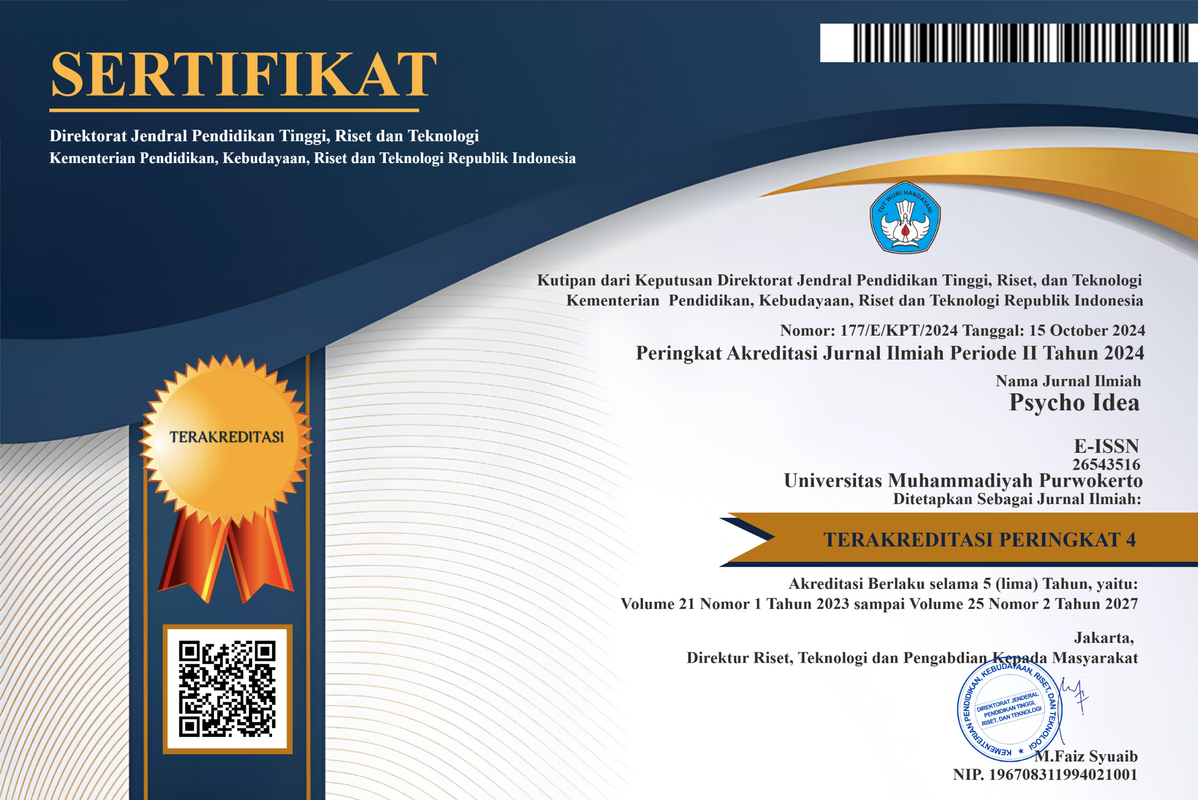PERSEPSI MASYARAKAT BANJAR TERHADAP KAPUHUNAN
DOI:
https://doi.org/10.30595/psychoidea.v16i2.3361Keywords:
Kapuhunan, Persepsi, MasyarakatAbstract
Dalam bahasa Banjar sebenarnya tidak ada kata “Kepohonan” tetapi yang ada adalah “Kapuhunan”. Huruf “e”=”a”, huruf “O”=”u”. Itulah pelafalan huruf dalam bahasa Banjar yang mendominasi bahasa di Kalimantan, khususnya Kalimantan Selatan. Didalam adat Banjar mitos Kapuhunan adalah suatu kejadian yang terjadi ketika seseorang dalam tubuhnya dirasuki atau dimasuki atau diganggu oleh makhluk halus penunggu pohon yang menyebabkan orang tersebut bertingkah laku tidak sewajarnya.Untuk itu perlunya mengetahui persepi dari masyarakat Banjarmasin itu sendiri tentang budaya Kapuhunan. Penulisan ini bertujuan untuk menguraikan persepsi masyarakat Banjar mengenai kapuhunan, subjek yang digunakan adalah masyrakat dari suku Banjar dan metode yang digunakan dalam penelitian ini dengan menggunakan pendekatan kualitatif studi fenomologi dengan teknik pengumpulan data menggunakan wawancara. Hasil dari penelitian ini adalah persepsi kapuhunan sudah mengalami pergeseran makna. Saat ini, kapuhunan dipersepsikan sebagai tulah atau kesialan.
Kata Kunci: Kapuhunan; Persepsi; Masyarakat
ABSTRACT
In the Banjar language there is actually no word "petition" but the existing one is "kapuhunan". The letter "e" = "a", the letter "O" = "u". that is the pronunciation of the letters in the Banjar language that dominates the language in Kalimantan, especially South Kalimantan. In Banjir myth Kapuhunan myth is an incident that occurs when a person in his body is possessed or entered or disturbed by the spirit of tree watcher that causes the person to behave inappropriately. To that end perlunyamengetahui percepi from Banjarmasin society itself about Kapuhunan culture. This writing aims to describe the perception of Banjar society about kapuhunan, the subjects used are the community of the Banjar tribe and the method used in the research by using a qualitative approachstudifenomologidata collection using interviews. The result of this research is that the perception of the kapuhunan has undergone a shift in meaning. Currently, kapuhunan perceived as plagues or bad luck.
Keywords: Kapuhunan; Perception; Society
References
Herdiansyah, H.(2015). Metodologi Penelitian Kualitatif untuk Ilmu Psikologi. Jakarta: Salemba Humanika
Kawi, D. (2002). Bahasa Banjar Dialek dan Subdialeknya.Banjarmasin : PT Grafika Wangi kalimantan
Koentjaraningrat. (2015). Pengantar Ilmu Antropologi.Jakarta : PT RinekaCipta
Matsumoto, D. (2008). Pengantar Psikologi Lintas Budaya. Yogyakarta:PustakaPelajar.
Sarwono, S.W. (2015). Psikologi Sosial Individu dan Teori-Teori Psikologi Sosial. Jakarta:BalaiPustaka
Sarwono, S.W & Meinarno, E. A. (2014).Psikologi Sosial. Jakarta: Salemba Humanika.
Suciati.(2015). Psikologi Komunikasi Sebuah Tinjauan Teoritis dan Perspektif Islam.
Soekanto, S & Sulistyowati, B. (2015).Sosiologi Suatu Pengantar. Jakarta : PT Raja Grafindo Persada
Walgito, B. (2003). Psikologi Sosial (Suatu Pengantar).Yogyakarta : ANDI
Downloads
Published
Issue
Section
License
Authors published in this journal agree to the following terms:
- The copyright of each article is retained by the author (s) without restrictions
- The journal allows the author(s) to retain publishing rights without restrictions
- The author grants the journal the first publication rights with the work simultaneously licensed under the Creative Commons Attribution License, allowing others to share the work with an acknowledgment of authorship and the initial publication in this journal.
- Authors may enter into separate additional contractual agreements for the non-exclusive distribution of published journal versions of the work (for example, posting them to institutional repositories or publishing them in a book), with acknowledgment of their initial publication in this journal
- Authors are permitted and encouraged to post their work online (For example in the Institutional Repository or on their website) before and during the submission process, as this can lead to productive exchanges, as well as earlier and larger citations of published work
- Articles and all related material published are distributed under a Creative Commons Attribution-4.0 International Public License (CC - BY 4.0).
License
Psycho Idea is licensed under a Creative Commons Attribution- 4.0 International Public License (CC - BY 4.0).
You are free to :
Share — copy and redistribute the material in any medium or format
Adapt — remix, transform, and build upon the material for any purpose, even commercially











